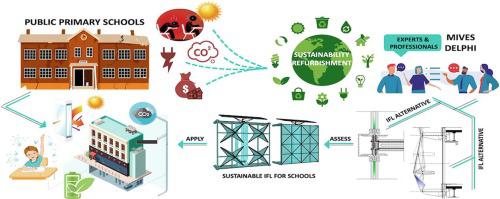Sustainable Energy Technologies and Assessments ( IF 7.1 ) Pub Date : 2020-10-19 , DOI: 10.1016/j.seta.2020.100839 Saeid Habibi , Oriol Pons Valladares , Diana Peña

|
In regard to increasing reports toward severe comfort problems and high energy consumption by educational buildings in many countries, a sustainable refurbishment for these edifices is urgently required. Using Intelligent Façade Layers as a protective cover with a variety of possible energy sources would be an innovative rehabilitation alternative, which until now has had outstanding performances in other architectural applications.
This research paper, overcoming the lack of comprehensive assessments on Intelligent Façades, develops a new model to quantitatively assess the sustainability of these façades when applied to optimize existing educational architecture. This model combines the multi-criteria decision-making MIVES method with the Delphi technique, relying on literature, real projects and sensitivity analyses. The model considers the main economic, environmental and social aspects in its steps: 1) model boundaries, 2) experts’ qualification, 3) requirements tree, 4) weights assignment, 5) value functions, 6) sustainability indexes and 7) most sustainable alternatives. This model has been applied and validated in five Intelligent Façade Layers alternatives and three case studies at schools in Barcelona, Spain. This new approach proved highly reliable, showing the need for optimizations in both economic and environmental impacts applied to refurbishment scenarios. In this sense, future steps will design optimized alternatives.
中文翻译:

应用于翻新学校建筑外皮的智能外立面层的新型可持续性评估模型
关于许多国家关于教育建筑物严重的舒适性问题和高能耗的报道越来越多,迫切需要对这些建筑物进行可持续的翻新。使用智能立面层作为具有多种可能能源的防护罩将是一种创新的修复替代方案,迄今为止,它在其他建筑应用中均具有出色的性能。
本研究论文克服了对智能外立面缺乏全面评估的不足,开发了一种新模型来定量评估这些外立面在用于优化现有教育体系结构时的可持续性。该模型依靠文献,实际项目和敏感性分析,将多准则决策MIVES方法与Delphi技术相结合。该模型在其步骤中考虑了主要的经济,环境和社会方面:1)模型边界,2)专家资格,3)需求树,4)权重分配,5)价值函数,6)可持续性指标和7)最可持续备择方案。该模型已在西班牙巴塞罗那的学校中的五个智能外观层替代方案和三个案例研究中得到了应用和验证。这种新方法被证明是高度可靠的,表明需要对翻新方案中的经济和环境影响进行优化。从这个意义上讲,未来的步骤将设计出优化的替代方案。











































 京公网安备 11010802027423号
京公网安备 11010802027423号